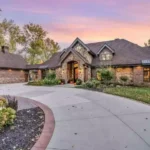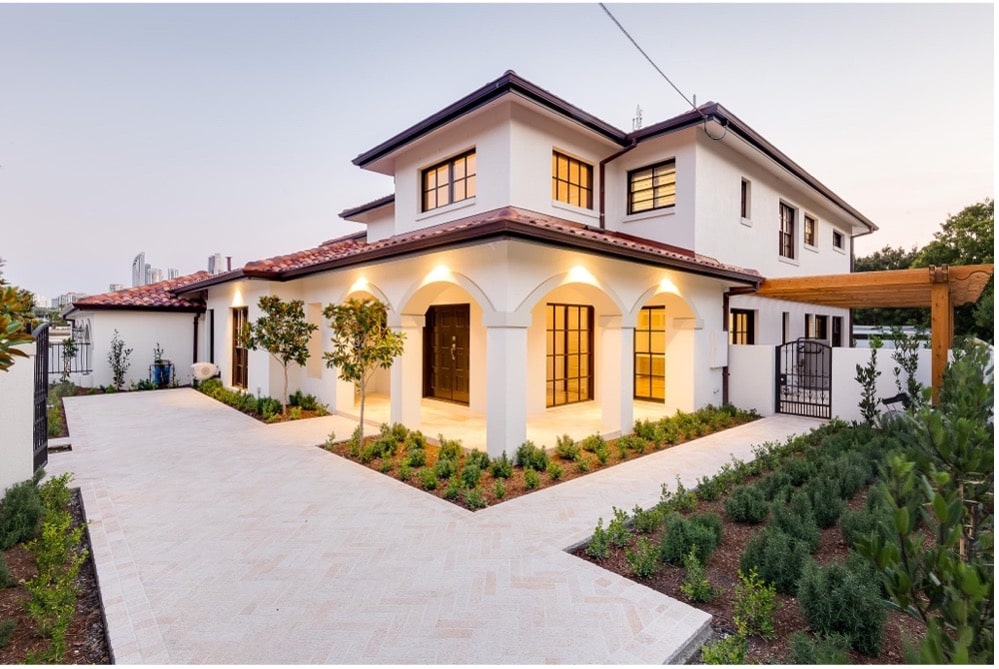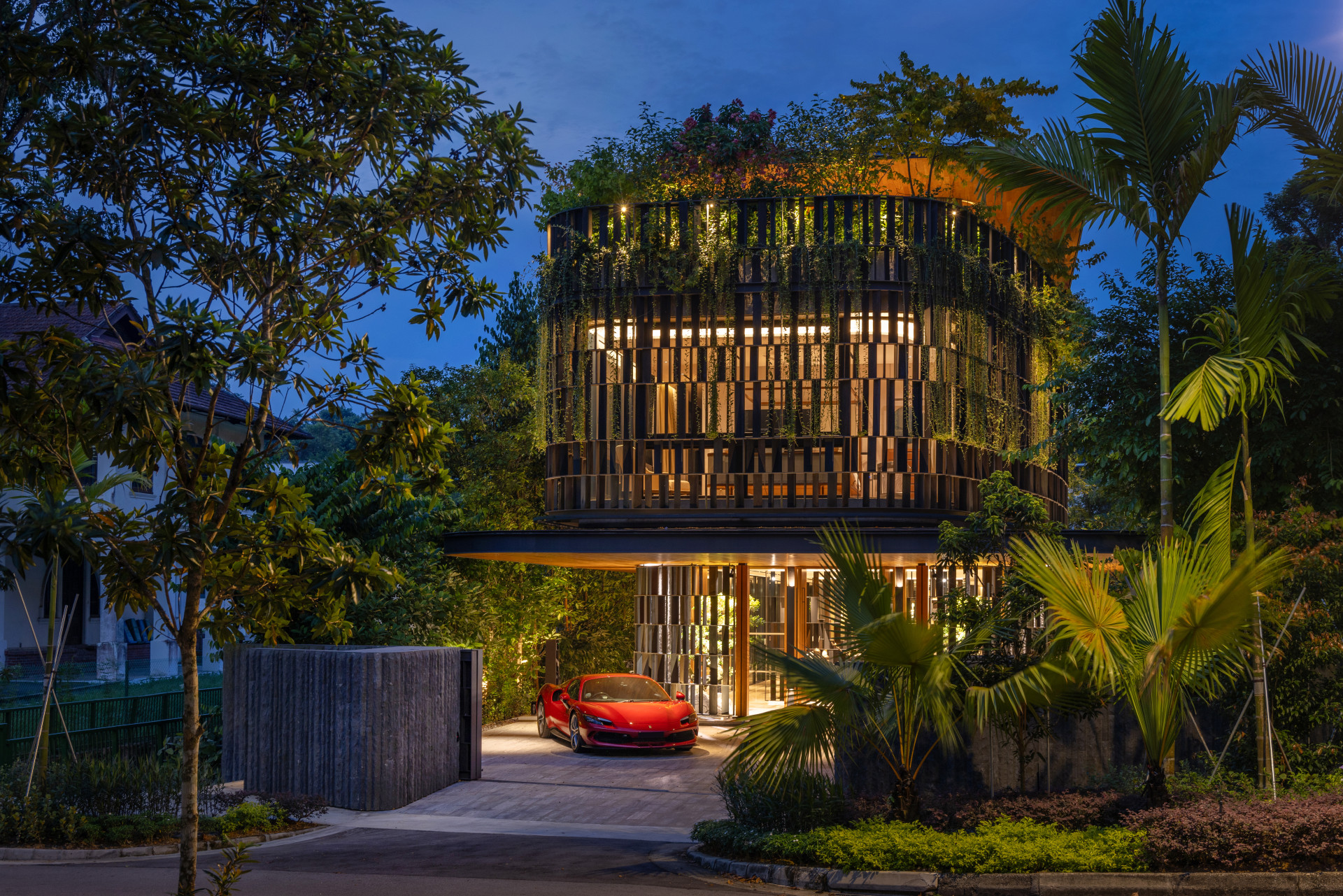As you step through a grand archway, the smell of sun-baked terracotta and the faint aroma of olive trees fill the air. You look up to see an expansive tiled roof, its warm orange hues casting a comforting glow in the afternoon light. Winding around the courtyard, a line of sturdy stone columns supports elegant archways, while bougainvillaea vines drape over iron balconies, framing views of the deep blue Mediterranean Sea. There’s a sense of serenity here—a connection to the ancient world that feels eternal yet somehow fresh and alive. This is the magic of a Mediterranean mansion: a blend of rugged natural beauty and refined luxury where history and comfort coexist.
Mediterranean mansions have a unique architectural style and appeal that have captivated people for centuries. From the coastlines of Spain and Italy to the rolling hills of Greece, these mansions represent more than just homes; they embody a lifestyle that embraces nature, simplicity, and elegance. But what defines a Mediterranean mansion? What makes it alluring, and why are they still highly valued in the modern real estate market? Let’s dive into these iconic homes’ history, architectural features, and current status.
The Origins of Mediterranean Mansions: A History Shaped by Climate and Culture
The Mediterranean mansion’s design has roots stretching back thousands of years, deeply influenced by the cultures and climates of southern Europe and North Africa. Civilizations like the Greeks, Romans, and Moors contributed to the Mediterranean architectural style we recognize today. The Romans, for instance, were among the first to build villas around central courtyards, which allowed for natural cooling and created a communal space at the heart of the home.
After the Roman Empire, the Moors, who controlled much of Spain for centuries, introduced features like intricate tilework, arched doorways, and elaborate gardens. As a result, Mediterranean architecture became a fusion of Roman, Moorish, and Renaissance influences, focusing on functionality and aesthetic appeal.
The Mediterranean mansion as we know it today started gaining popularity in the United States in the early 20th century. Wealthy Americans vacationing in the Mediterranean were captivated by the style and began replicating it back home, especially in California and Florida coastal areas. By the 1920s, Mediterranean Revival architecture flourished in America, with famed architects like Addison Mizner designing iconic mansions in Palm Beach, Florida (Source: Architectural Digest).
Vital Architectural Features of Mediterranean Mansions
Mediterranean mansions are characterized by specific design elements that make them instantly recognizable. Here are some key features:
- Red Tiled Roofs: Perhaps the most defining feature is that the clay or terracotta tiles are durable and perfect for withstanding the Mediterranean climate. They also add a rustic, warm aesthetic to the home.
- Stucco Exteriors: Mediterranean mansions often have thick stucco walls, which help insulate the interior from the heat and give the home a clean, natural appearance. White stucco is especially popular, reflecting sunlight and helping to keep the house cool.
- Arches and Columns: Mediterranean mansions often have arched doorways, windows, and colonnades, a design element influenced by Roman and Moorish influences. The arches soften the house’s lines, creating an inviting, flowing feel.
- Courtyards and Gardens: Mediterranean mansions typically incorporate open courtyards or central patios surrounded by the home’s main rooms. These outdoor spaces often feature fountains, tiled pathways, and lush greenery, serving as tranquil, shaded retreats.
- Balconies and Terraces: Mediterranean homes are designed to integrate indoor and outdoor living. Balconies, verandas, and expansive terraces offer beautiful views and are perfect for enjoying warm evenings by the sea.
- Ornamental Ironwork: Wrought iron is frequently used for gates, railings, and window grilles, adding a touch of craftsmanship and elegance. This is both decorative and functional, providing security and style.
These architectural features make Mediterranean mansions stunning and practical for warm climates, where outdoor living and cooling structures are essential.
Statistics: The Demand and Value of Mediterranean Mansions in the Global Market
The demand for Mediterranean-style homes remains strong, especially in coastal areas and affluent neighbourhoods. According to Knight Frank’s 2023 Wealth Report, Mediterranean-style properties saw an average price increase of 8% in regions like California, the French Riviera, and the Spanish coast over the past year, driven by demand from both local and international buyers (Source: Knight Frank Wealth Report 2023).
Mediterranean Revival homes are trendy in California and Florida. Data from the National Association of Realtors shows that these homes sell at a premium compared to other architectural styles, averaging around 20-30% higher than non-Mediterranean homes in the same region. For example, a Mediterranean mansion in a prime location in Los Angeles can fetch anywhere from $5 million to $30 million, depending on the size and condition (Source: Zillow Market Report).
Mediterranean mansions along the French and Italian coastlines are among the most expensive properties in Europe. A 2023 report from Sotheby’s International Realty highlighted that properties in the French Riviera, for instance, often exceed €10 million, with ultra-luxury estates reaching upwards of €100 million. The Mediterranean lifestyle and unique architectural style have proven irresistible to high-net-worth individuals, especially those from colder climates seeking a sunlit retreat.
Modern-Day Appeal: Why Mediterranean Mansions Are Still in Demand
Today, Mediterranean mansions offer more than a luxurious aesthetic; they provide a lifestyle centred around relaxation, connection to nature, and open-air living. With the rise of remote work, many affluent buyers are seeking properties where they can enjoy the natural beauty and pleasant climate all year round. With their spacious courtyards, balconies, and scenic views, Mediterranean mansions perfectly meet this need.
Moreover, modern Mediterranean mansions often blend classic design with contemporary amenities. Homeowners are incorporating smart home technology, eco-friendly materials, and sustainable practices while preserving Mediterranean architecture’s charm and historical character. Features like solar panels, energy-efficient windows, and water-saving landscapes have become increasingly common in these properties (Source: Sustainable Architecture Journal).
The COVID-19 pandemic also influenced buyer preferences, increasing interest in homes offering luxury and privacy. Mediterranean mansions, typically situated in spacious areas with private gardens, swimming pools, and access to natural landscapes, became ideal choices for those seeking a retreat from city life.
Challenges of Owning a Mediterranean Mansion
Owning a Mediterranean mansion comes with its own set of challenges. Upkeep can be costly, especially if the property is older and located in coastal areas where salt and humidity can accelerate wear and tear. The maintenance of large outdoor areas, from gardens to tiled courtyards, can add tens of thousands of dollars annually to ownership costs.
Additionally, traditional building materials like terracotta and stucco require regular maintenance. These materials can crack or erode without proper care, especially in areas with fluctuating weather. Restorations for historically significant European Mediterranean mansions can be particularly challenging due to strict regulations protecting architectural heritage (Source: European Heritage Journal).
Conclusion: The Timeless Appeal of Mediterranean Mansions
Mediterranean mansions embody a unique blend of history, culture, and luxury. With their distinctive architectural features, connection to nature, and relaxing lifestyle, they continue to capture the imagination of homeowners worldwide. Whether it’s a hilltop villa overlooking the sea in Italy or a Spanish-inspired estate in California, Mediterranean mansions offer an experience that is as timeless as it is appealing.
Despite the costs and challenges, owning a Mediterranean mansion remains a dream for many. It offers a home and a lifestyle filled with beauty, elegance, and tranquillity. As modern architecture continues to evolve, the Mediterranean mansion reminds us that some styles are simply too exquisite to fade away.












 Afrikaans
Afrikaans Shqip
Shqip አማርኛ
አማርኛ العربية
العربية Հայերեն
Հայերեն Azərbaycan dili
Azərbaycan dili Euskara
Euskara Беларуская мова
Беларуская мова বাংলা
বাংলা Bosanski
Bosanski Български
Български Català
Català Cebuano
Cebuano Chichewa
Chichewa 简体中文
简体中文 繁體中文
繁體中文 Corsu
Corsu Hrvatski
Hrvatski Čeština
Čeština Dansk
Dansk Nederlands
Nederlands English
English Esperanto
Esperanto Eesti
Eesti Filipino
Filipino Suomi
Suomi Français
Français Frysk
Frysk Galego
Galego ქართული
ქართული Deutsch
Deutsch Ελληνικά
Ελληνικά ગુજરાતી
ગુજરાતી Kreyol ayisyen
Kreyol ayisyen Harshen Hausa
Harshen Hausa Ōlelo Hawaiʻi
Ōlelo Hawaiʻi עִבְרִית
עִבְרִית हिन्दी
हिन्दी Hmong
Hmong Magyar
Magyar Íslenska
Íslenska Igbo
Igbo Bahasa Indonesia
Bahasa Indonesia Gaeilge
Gaeilge Italiano
Italiano 日本語
日本語 Basa Jawa
Basa Jawa ಕನ್ನಡ
ಕನ್ನಡ Қазақ тілі
Қазақ тілі ភាសាខ្មែរ
ភាសាខ្មែរ 한국어
한국어 كوردی
كوردی Кыргызча
Кыргызча ພາສາລາວ
ພາສາລາວ Latin
Latin Latviešu valoda
Latviešu valoda Lietuvių kalba
Lietuvių kalba Lëtzebuergesch
Lëtzebuergesch Македонски јазик
Македонски јазик Malagasy
Malagasy Bahasa Melayu
Bahasa Melayu മലയാളം
മലയാളം Maltese
Maltese Te Reo Māori
Te Reo Māori मराठी
मराठी Монгол
Монгол ဗမာစာ
ဗမာစာ नेपाली
नेपाली Norsk bokmål
Norsk bokmål پښتو
پښتو فارسی
فارسی Polski
Polski Português
Português ਪੰਜਾਬੀ
ਪੰਜਾਬੀ Română
Română Русский
Русский Samoan
Samoan Gàidhlig
Gàidhlig Српски језик
Српски језик Sesotho
Sesotho Shona
Shona سنڌي
سنڌي සිංහල
සිංහල Slovenčina
Slovenčina Slovenščina
Slovenščina Afsoomaali
Afsoomaali Español
Español Basa Sunda
Basa Sunda Kiswahili
Kiswahili Svenska
Svenska Тоҷикӣ
Тоҷикӣ தமிழ்
தமிழ் తెలుగు
తెలుగు ไทย
ไทย Türkçe
Türkçe Українська
Українська اردو
اردو O‘zbekcha
O‘zbekcha Tiếng Việt
Tiếng Việt Cymraeg
Cymraeg isiXhosa
isiXhosa יידיש
יידיש Yorùbá
Yorùbá Zulu
Zulu